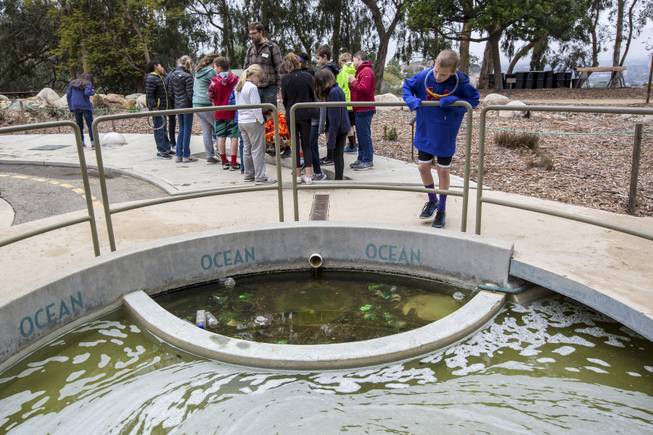
Monica Almeida / The New York Times
Nathan Bock, an educator with TreePeople Center for Community Forestry, leads schoolchildren on a tour Jan. 15 to show how polluted runoff water is dumped into the ocean in Los Angeles.
Tuesday, Feb. 23, 2016 | 2 a.m.
LONG BEACH, Calif. — The winter rains finally arrived in Southern California, bringing drenching relief last week to a part of the nation suffering one of the worst droughts in history. But the El Niño storms brought something else as well: a reminder of lost opportunity, on display in this coastal city, as millions of gallons of stormwater slipped down the usually dry Los Angeles River and out into San Pedro Bay.
After a year in which Californians cut water use by 25 percent, stormwater has become the next front in what amounts to a fundamental restructuring of Southern California’s relationship with its intricate water network. More than 200 billion gallons of stormwater, enough to supply 1.4 million households for a year, could be captured statewide — but instead end up spilling down sewers, drains and into the ocean, as was on display Thursday, in the hours after the rainfall had ended, at the spot where the Los Angeles River ends here.
Nowhere is the disparity felt more than in parched Los Angeles, with its short winters and its overwhelming reliance on water imported from Northern California and the Colorado River. For nearly a century, since deadly floods in 1938 killed 97 people, engineers have focused on ways to flush stormwater safely out of Los Angeles as quickly as possible. Now, officials want to capture that water.
“Something that was once viewed as a nuisance is now seen as a necessity,” said Eric Garcetti, the mayor of Los Angeles. “We haven’t done enough.”
Garcetti invoked the legacy of William Mulholland, the city engineer who oversaw the construction of the Los Angeles Aqueduct, as he outlined policy intended to press Los Angeles to increase the amount of stormwater captured, to 50 billion gallons by 2035 from 8.8 billion gallons now. “This is a Mulholland moment,” he said in an interview. “I intend to re-engineer the water system again to keep water here.”
Still, the long-predicted El Niño rains have yet to arrive with the fury that has been promised. While there was heavy rain — and just as critically, snow — in Northern California through January, Southern California has been baking in record-high temperatures.
The rain here Thursday was the first major precipitation in more than a month.
Potentially more worrisome, the heavy January rains and snows that socked the northern part of the state — home to most of California’s reservoirs — have not kept pace into February.
The snowpack, a critical measure which provides water as it melts into the spring, was at 94 percent of normal statewide last week.
Still, meteorologists, pointing to the history of El Niño storms, said the heaviest rains could arrive this week and in March and April.
The renewed focus on stormwater that began five years ago appears to have intensified in recent months.
Efforts seem to be hastened by the drought, the promise of El Niño, and the widening view — promoted by people like Gov. Jerry Brown, a Democrat — that because of climate change, California is entering into hotter and drier times that will tax an already overburdened water system.
“The view has changed from seeing stormwater as a problem to seeing stormwater as an opportunity,” said Richard Luthy, a professor of civil and environmental engineering at Stanford University. “By capturing stormwater, we can take advantage of a local water source to augment our urban water supply. This would mean we would become less dependent on imported water; it means we would have greater resilience against droughts.”
He added: “There’s a realization that the answer to our problem can’t be taking water from someone else or somewhere else. Those days are over. There’s no more water to go get.”
This shift in approach will not be easy.
The State Water Resources Control Board had earlier authorized spending $200 million on an array of projects devoted to capturing stormwater. But officials said it would cost more than $1 billion for the kind of ambitious water-collection goals set by Los Angeles, San Diego and the San Francisco Bay Area.
There is no indication where that money might come from, though Garcetti noted that in Los Angeles, at least, there would be significant cost savings by cutting back the water the city now needs to buy. Los Angeles imports about 85 percent of its drinking water.
Nearly two-thirds of Los Angeles is paved, meaning water that might otherwise soak into the ground runs down streets, driveways and sidewalks and into sewers. On its way, it picks up pollutants before flowing into the Los Angeles River, which cuts across 43 miles of the region before reaching the ocean.
“Stormwater is an important new resource for California that is underappreciated and undercaptured,” said Peter Gleick, a founder of the Pacific Institute, an environmental advocacy group. “Governments increasingly see this as a resource, but it takes time. We are going to see a lot of water this year flood out to the ocean.”
In the future, Gleick said, “we are not going to solve California water problems with traditional big massive infrastructure that we have built in the past.”

Join the Discussion:
Check this out for a full explanation of our conversion to the LiveFyre commenting system and instructions on how to sign up for an account.
Full comments policy